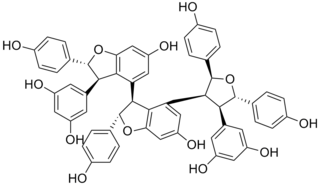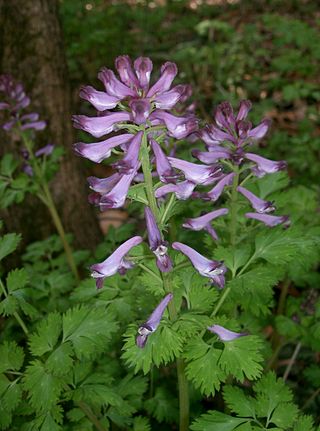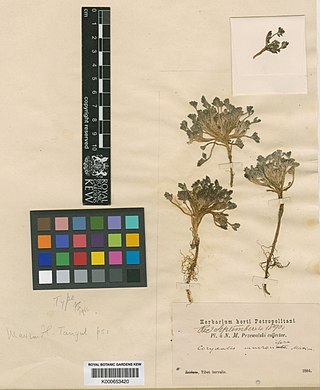
Galantamine is used for the treatment of cognitive decline in mild to moderate Alzheimer's disease and various other memory impairments. It is an alkaloid that has been isolated from the bulbs and flowers of Galanthus nivalis, Galanthus caucasicus, Galanthus woronowii, and some other members of the family Amaryllidaceae, such as Narcissus (daffodil), Leucojum aestivum (snowflake), and Lycoris including Lycoris radiata. It can also be produced synthetically.

Corydalis is a genus of about 470 species of annual and perennial herbaceous plants in the family Papaveraceae, native to the temperate Northern Hemisphere and the high mountains of tropical eastern Africa. They are most diverse in China and the Himalayas, with at least 357 species in China.

Huperzine A is a naturally occurring sesquiterpene alkaloid compound found in the firmoss Huperzia serrata and in varying quantities in other food Huperzia species, including H. elmeri, H. carinat, and H. aqualupian. Huperzine A has been investigated as a treatment for neurological conditions such as Alzheimer's disease, but a meta-analysis of those studies concluded that they were of poor methodological quality and the findings should be interpreted with caution. Huperzine A inhibits the breakdown of the neurotransmitter acetylcholine by the enzyme acetylcholinesterase. It is commonly available over the counter as a nutrient supplement, and is marketed as a cognitive enhancer for improving memory and concentration.

Lactucopicrin (Intybin) is a bitter substance that has a sedative and analgesic effect, acting on the central nervous system. It is a sesquiterpene lactone, and is a component of lactucarium, derived from the plant Lactuca virosa, as well as being found in some related plants such as Cichorium intybus. It is also found in dandelion coffee.

Bulbocapnine is an alkaloid found in Corydalis and Dicentra, genera of the plant family Fumariaceae which have caused the fatal poisoning of sheep and cattle. It has been shown to act as an acetylcholinesterase inhibitor, and inhibits biosynthesis of dopamine via inhibition of the enzyme tyrosine hydroxylase. Like apomorphine, it is reported to be an inhibitor of amyloid beta protein (Aβ) fiber formation, whose presence is a hallmark of Alzheimer's disease (AD). Bulbocapnine is thus a potential therapeutic under the amyloid hypothesis. According to the Dorlands Medical Dictionary, it "inhibits the reflex and motor activities of striated muscle. It has been used in the treatment of muscular tremors and vestibular nystagmus".

Corydalis solida, fumewort or bird-in-a-bush, is a species of flowering plant in the family Papaveraceae, native to moist, shady habitats in northern Europe and Asia. Growing to 25 cm (10 in), it is a spring ephemeral, with foliage that appears in spring and dies down to its tuberous rootstock in summer. It is cultivated for its deeply divided, ferny leaves and narrow, long-spurred flowers which appear in spring. The flowers show color variation, and may be mauve, purple, red, or white.

α-Viniferin is a stilbene trimer. It can be isolated from Caragana chamlagu and from Caragana sinica and from the stem bark of Dryobalanops aromatica. It is also present in relation to resistance to Botrytis cinerea and Plasmopara viticola in Vitis vinifera and Vitis riparia.It has been shown to inhibit acetylcholinesterase.

Kobophenol A is a stilbenoid. It is a tetramer of resveratrol. It can be isolated from Caragana chamlagu, from Caragana sinica and from Carex folliculata seeds.

Tetrahydrocoptisine is an alkaloid isolated from Corydalis impatiens.

Acetylcorynoline is a bio-active isolate of Corydalis ambigua. It inhibits the maturing of bone marrow-derived dendritic cells in mice. However, it is only cytotoxic in amounts of greater than 20 μM.

Corydaline is an acetylcholinesterase inhibitor isolated from Corydalis yanhusuo.

Cyclanoline is an acetylcholinesterase inhibitor isolated from Stephania venosa tuber.

Ungiminorine is an acetylcholinesterase inhibitor isolated from Narcissus.

Dehydrocorybulbine (DHCB) is an alkaloid isolated from Corydalis yanhusuo. Dehydrocorybulbine binds to the dopamine D1 receptor.
Corydalis yanhusuo is a plant species in the genus Corydalis. The Chinese name for Corydalis yanhusuo is yan hu suo. The Japanese common name is engosaku (エンゴサク) and the Korean common name is hyeonhosaek (현호색). English common names include yanhusuo, corydalis, and Asian corydalis. The tuber of this plant, frequently mislabeled as the root, is an important therapeutic agent in traditional Chinese medicine. It is native to high-altitude grasslands across China including in the provinces of Anhui, Henan, Hubei, Hunan, Jiangsu, and Zhejiang, but is more widely cultivated.

Ungeremine is a betaine-type alkaloid isolated from Nerine bowdenii and related plants such as Pancratium maritimum. Pharmacologically, it is of interest as an acetylcholinesterase inhibitor and accordingly as possibly relevant to Alzheimer's disease. It also has been investigated as a bactericide.

Daniel Atha is a botanist. In his work as a botanist he has collected plants in all 50 states of the United States, as well as several additional countries. Atha's work was focused on three areas: "floristics—what plants grow in a particular region; taxonomy—how to tell one plant from another, what to call it and what it's related to; and applied botany—how plants are used for food, medicine, shelter and other useful purposes." Atha has been known as a prominent regional botanist, and the high-profile botanical projects with which he has been involved have garnered national and international attention.

Corydalis incisa, incised fumewort, is an annual or biennial herbaceous species of plant in the poppy family. It is also known as purple keman or murasa-kike-man. Some authorities report it in the family Fumariaceae. The wildflower is native to Japan, Korea, Taiwan, and China, found in forests, clearings, and irrigation channels.

Guanitoxin (GNT), formerly known as anatoxin-a(S) "Salivary", is a naturally occurring cyanotoxin commonly isolated from cyanobacteria and causes excess salivation in mammals via inhibition of acetylcholinesterase. Guanitoxin was first structurally characterized in 1989, and consists of a cyclic N-hydroxyguanine organophosphate with a phosphate ester moiety.

Corydalis mucronifera is a plant which does not have a common name as it is quite rare in nature. This plant has also previously been recorded as Corydalis boweri. Being as rare as it is, it has only been found in two regions: China and Tibet. The range where the plant can be found is small as it is only found near rocky beaches or high mountain ranges at altitudes between 4200 and 5300 meters. Corydalis mucronifera is small in size and displays a variety of colors: purple, yellow, white, and cream. The plant has similar structures to other plants found in Europe and North America as it displays a racemose corymb. Due to its herbal properties, it is currently being studied in medicine for its inhibitory properties; these properties are focused in studies regarding neurodegenerative disorders.



















